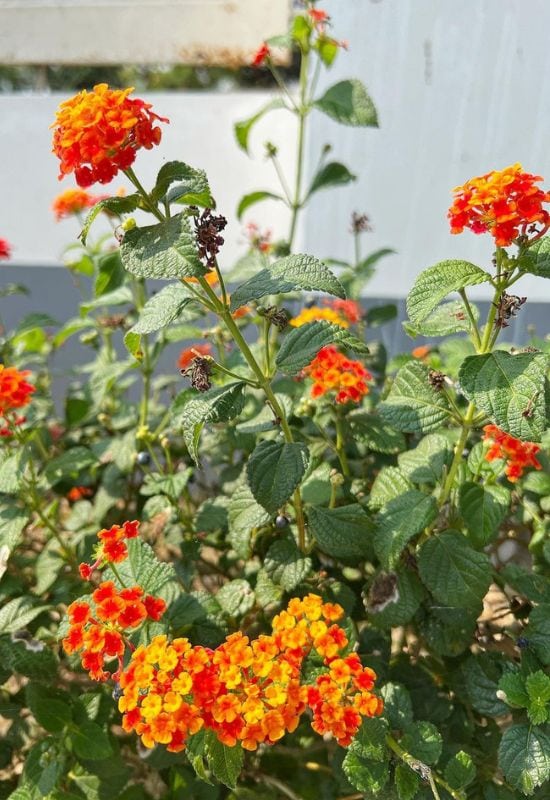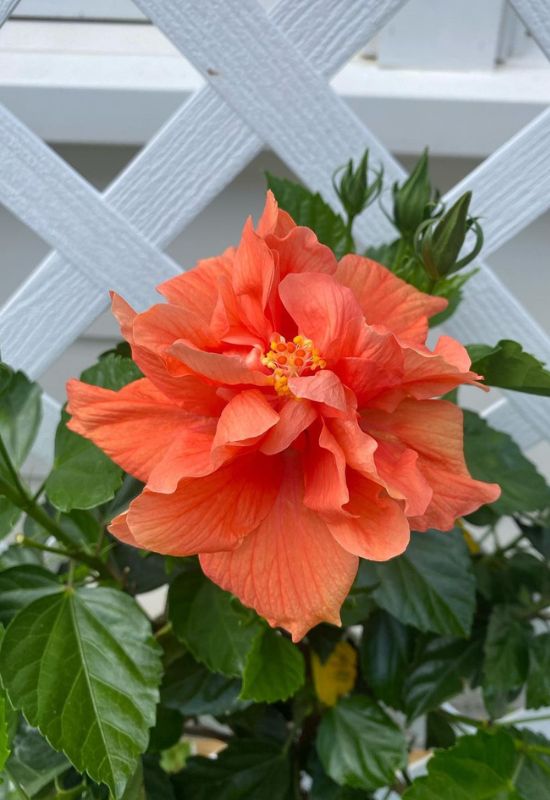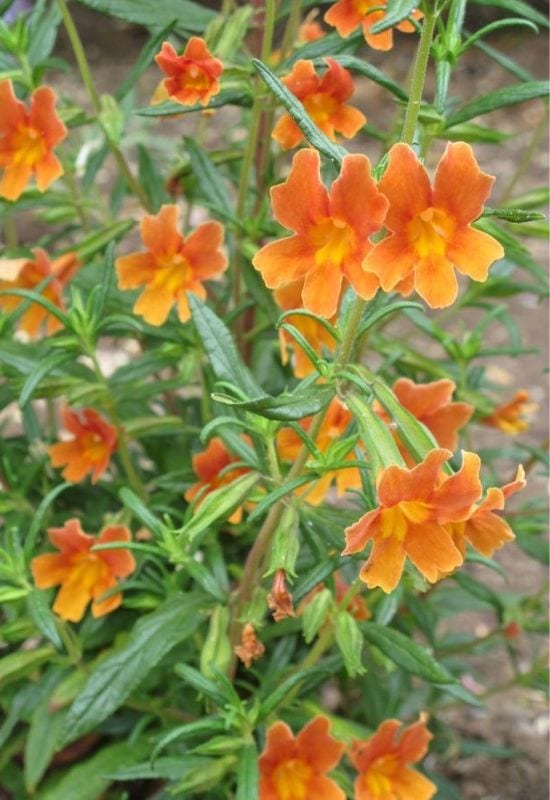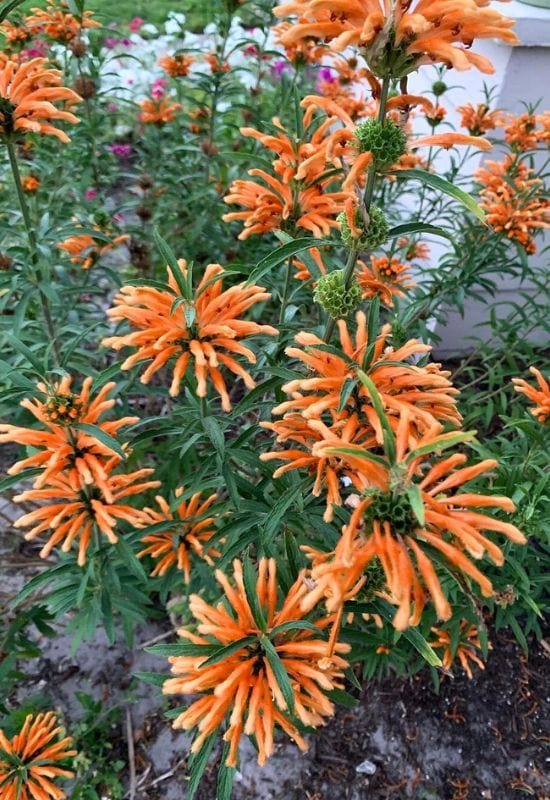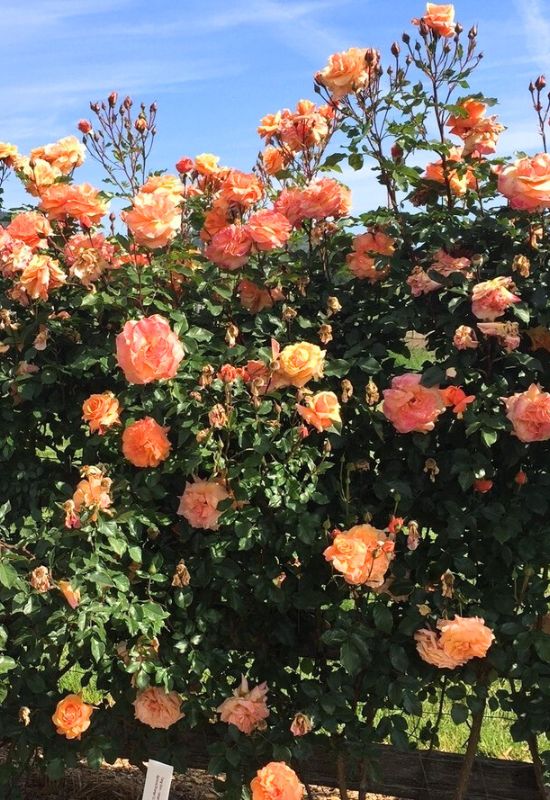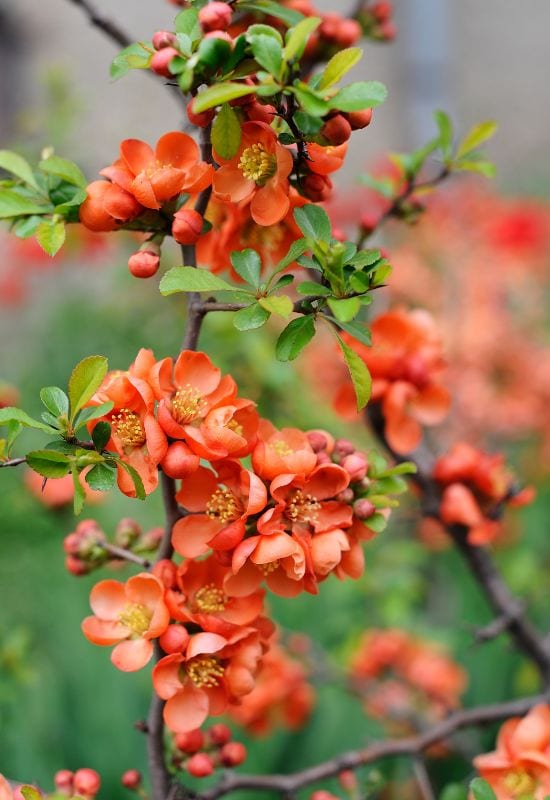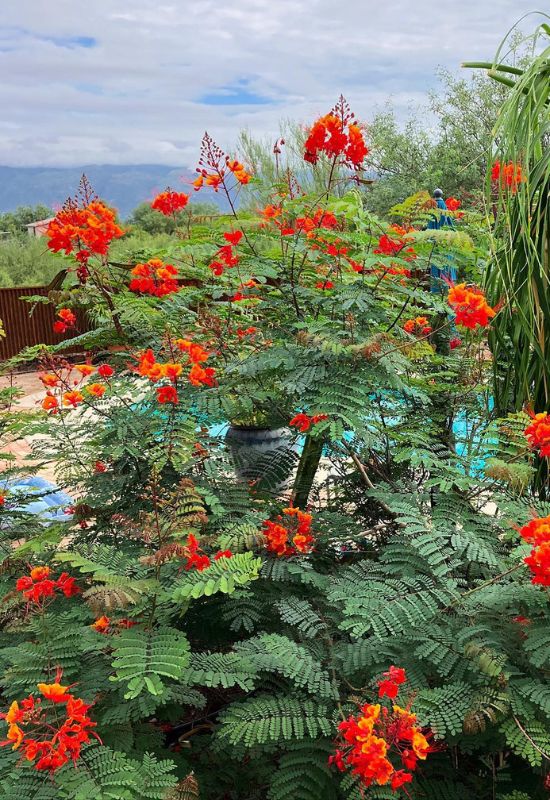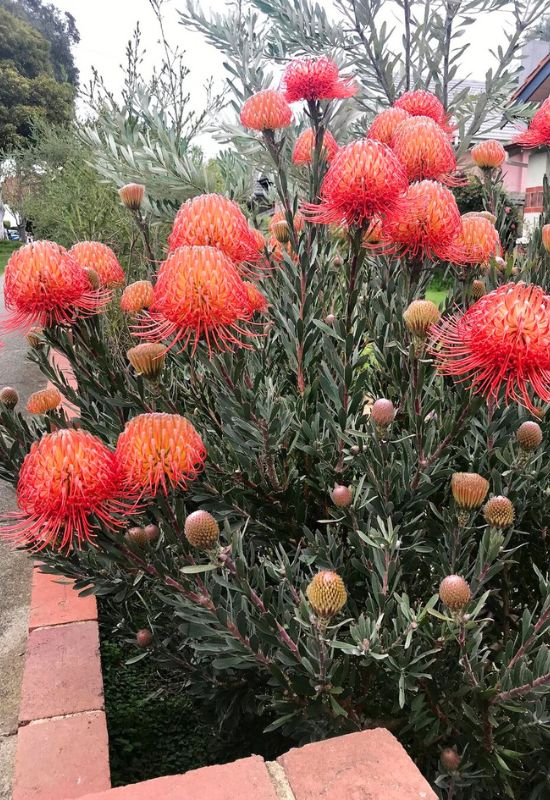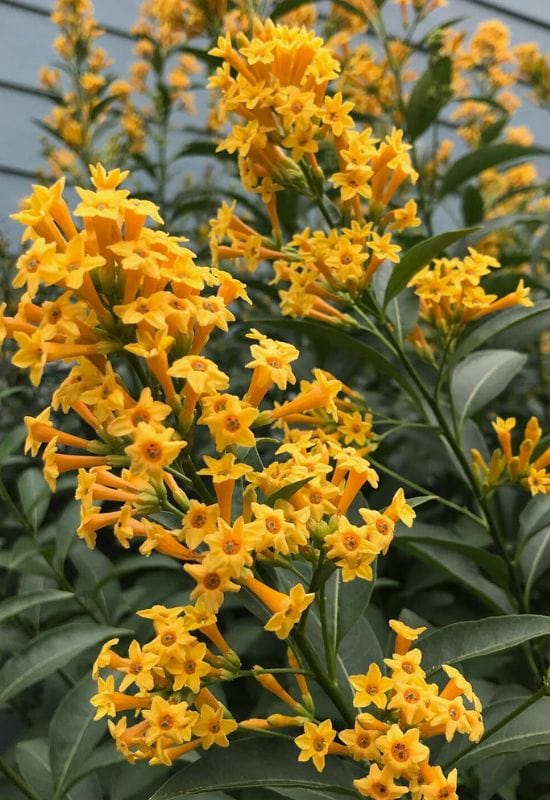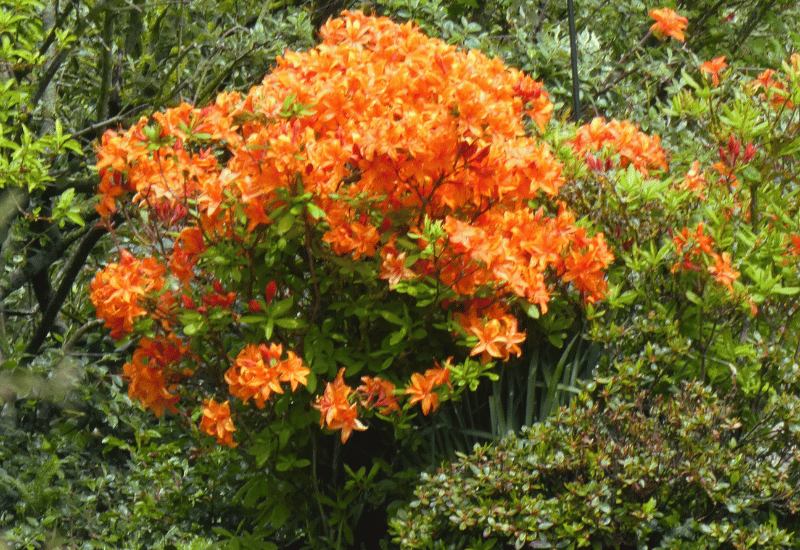
Bright, energetic, symbolic and flourishing all year round in your garden! What am I talking about? Beautiful orange flowers on lush shrubs, of course!
And yes, I do mean in winter as well, because there are varieties of bushes with flowers in lovely and light filled shades of tangerine, honey, ginger or tiger for spring, for summer, for fall – but also for winter floral shows!
And this is a color range that’s impossible to miss: wherever it blossoms in your garden, your eye will be drawn to it – as well as those of your visitors, butterflies, bees and humming birds!
Exotic looking or with a wild and unruly personalities, with large blossoms or thousands of fragrant florets in vibrant and warm hue on the orange range, these evergreen or deciduous flowering shrubs are invaluable to bring a spark of life to your hedges and borders. And when the blooms are spent, these bushy beauties will still offer you green, florid and beautifully textured foliage!
Symbolic of enthusiasm, creativity, happiness and determination, orange is one of the brightest and most powerful colors ever, and if you need its power, light and strength in your garden, check out our list of most beautiful orange-flowering shrubs that will make your garden shine!
Orange is not actually one of the most common colors for flowering shrubs. You will find lists of varieties that turn out to have yellow or red blooms when you look at the closely. Well, the following are really, assuredly and decidedly orange!
Orange is not typically among the most commonly found colors for flowering shrubs. Often, upon closer inspection, many varieties that are listed as having orange blooms turn out to have yellow or red flowers instead. However, the following shrubs undoubtedly, confidently, and resolutely produce truly orange blooms!
And the first flowering shrub on our list is evocative of when orange is at its best and strongest: sunset, of course…
1: ‘Strybing Sunset’ Cigar Plant (Cuphea ‘Strybing Sunset’)
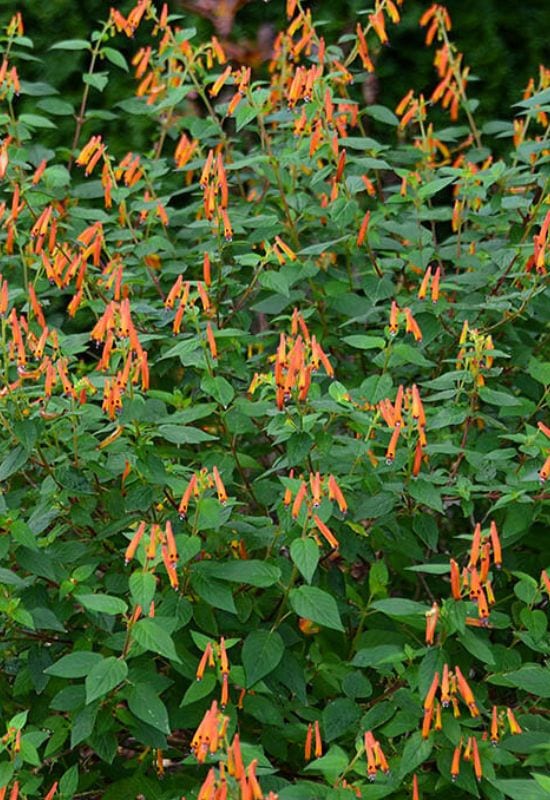
Cigar plant, or firecracker bush, is famous for its brightly colored blooms, that almost seem to shine. Most varieties tend to scarlet or red shades, but ‘Strybing Sunset’ is decidedly orange!
Its long and tubular flowers, in fact, display shades from darker tiger at the base and then brighten up to a luminous sunrise or candlelight tonality towards the mouth. And there you will find the small ruby upper lips, that look like ears, and a lovely magenta purple set of pistils that just about pop out of the blossom.
Bringing its energy to your garden from spring to frost, this shrub will also give you lush and dense, glossy deep olive green and lance shaped leaves and a very round habit.
Easy to grow and generous with its orange blossoms, ‘Srtrybing Sunset’ is a great shrub for informal beds and low hedges but you can easily grow it in a container as well, given its small but harmonic dimensions.
2: ‘Golden Lights’ Azalea (Rhododendron ‘Golden Lights’)
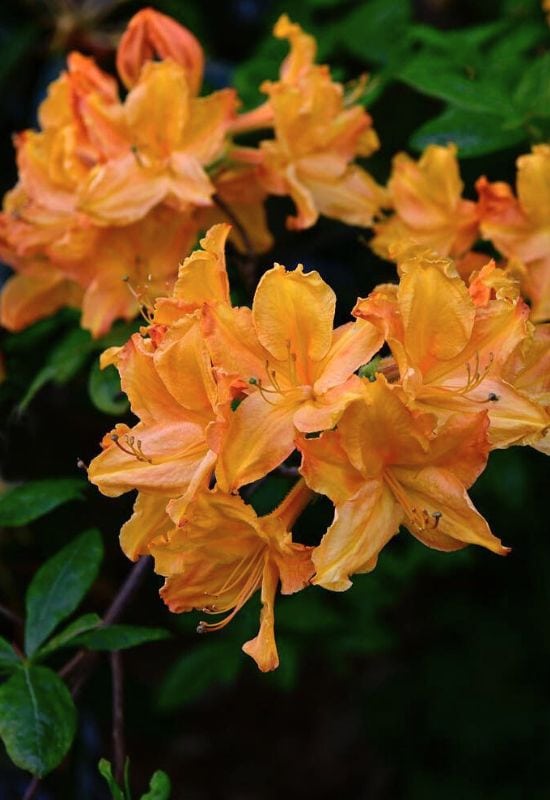
With Rhododendron varieties and orange blooms there is a problem; very often the color is unstable. However, ‘Golden Lights’ azalea has bright tangerine flowers, with dashes of fire on their five petals, and they are quite big – 2 inches, or 5.0 cm across.
They will literally cover the whole bush for about two months, in late spring and early summer, and they too may fade into pink and apricot later in their energetic display.
Member of the Norther Hybrid series bred by the University of Minnesota, this deciduous cultivar will also flare up with red buds on the naked branches, before the leaves unfurl.
The deep olive green foliage will then fill your garden with freshness and a sense of depth, and it is actually quite resistant to mildew, a rare quality in azaleas. Its exceptionality has gained it the Rhododendron of the Year Award.
A luminous variety of Rhododendron, ‘Golden Lights’ azalea will make a great foundation plant, or you can have this shrub in borders or for privacy screens, as long as your garden is informal, and, of course, it will also suit Japanese and Asian inspired designs.
3: ‘Bandana Orange’ Bigleaf Lantana (Lantana camara ‘Bandana Orange’)
Lantana is a famous because each inflorescence has an array of different colored florets that puzzles the mind, and you will often get some that are orange as well. But ‘Bandana Orange’, a bigleaf variety, will stick to one color: monarch orange, to be exact.
The lovely little flowers which are actually tubular, hide most of their little bodies in the dense clusters, and you will see their mouth, which look lovely and sweet, with their 5 broad and rounded petals and the tiny hole in the middle.
But that’s a cornucopia of nectar for pollinators, that will keep visiting your garden in search of it all through its long flowering season, from late spring to frost, and I have seen it blooming in winter as well in hot countries!
Did I forget to say that the blossoms are very generous indeed, and long lasting? They will decorate the herbaceous, mid green and dense evergreen foliage of this lovely bush like flames of energy, and they will also produce literally thousands of little fruits that small mammals and birds love – 1,200 per bush, to be exact!
A Sun and heat loving shrub, ‘Bandana Orange’ bigleaf lantana will suit any natural looking border, hedge or container, where it will keep small.
It is ideal for coastal and riverside gardens and it is quite common in public parks in hot countries, thanks to its long and profuse orange blooms and very low maintenance.
4: ‘Apricot Tart’ Hibiscus (Hibiscus ‘Apricot Tart’)
If you are looking for a medium sized shrub with really showy flowers of bright orange, do consider ‘Apricot Tart’ hibiscus, a recent cultivar introduced by C. Black in 2011. Its blossoms reach 8 inches across, which is 20 cm!
They have, as you guessed, a bright apricot tonality of our color, with a crumpled surface and veins in clear relief, and the margins are wavy… It gives you a strange smooth material like effect, silky, maybe.
Your eye is drawn to the center where you have a shiny rose pink halo surrounding a crimson center. And there you will see the staminal column rise in all its beauty with its candlelight hue!
This display will energize your garden during the summer months and beyond, while the lush, deep green and very dense foliage will keep you company from spring all the way to late fall.
For a jaw dropping orange floral display in a temperate region, ‘Apricot Tart’ is the perfect hibiscus variety, though it is only available from a few select nurseries. It will brighten up borders or hedges with its large flowers, or you may have it next to your home as a foundation shrub.
5: Bush Monkey Flower (Mimulus aurantiacus)
Bush monkey flower is a littleknown shrub from Oregon and California that really deserves more attention and credit. Its profuse, charming orange flowers will come in shades of salmon to fire, always in the orange range.
Blushing here and there on the sticky branches, they are tubular but with very open mouths and large frilly petals, quite exotic looking and about 1.2 inches across (3.0 cm).
They will bring their energy infused beauty to your garden from early spring to the end of summer, while the evergreen foliage will provide structure all year round.
The leaves are narrow, mid green and glossy, similar to those of olive trees. Despite not being widespread, it has won the famous Award of Garden Merit by the Royal Horticultural Society!
You can surprise your visitors with the charismatic beauty of bush monkey flower in borders or small hedges, but also in flower beds. It is super ideal for a Mediterranean or gravel garden style.
6: Lion’s Tail (Leonotis Leonurus)
For a wild looking shrub with a long and bright display of orange blooms, lion’s tail is hard to beat. This South African bloom will flare up in your garden all the way from late spring to frost, with tubular and arching goldfish to salamander orange flowers.
They end in two lips, and they come in clusters on top of its upright branches, attracting a sea of butterflies and even hummingbirds! Each blossom is about 2 inches long (5.0 cm) and fuzzy as well.
Their unruly and rebellious look is quite unique. And the semi evergreen foliage that accompanies it, long and narrow, dented and mid to dark green, adds to the natural looking presence of this energetic bush.
Most of the plant may die back in winter, in colder regions, but the woody parts will survive and it will come back next year.
Lion’s tail is only suitable for informal gardens, in particular cottage or Mediterranean in style, but if you have a naturalized area, it will certainly add lots of value to it.
low maintenance and adaptable to dry land, it will spark up borders or hedges, but also containers, with its long lasting orange floral displays.
7: ‘Strike It Rich’ Grandiflora Rose (Rosa ‘Strike It Rich’)
With shrub roses you want color but also delicacy and sophistication, so, the grandiflora variety ‘Strike it Rich’ is the first that springs to mind. Its fully double flowers can host up to 37 petals each, and they have a diameter of about 4 inches, or 10 cm.
Coming in dense clusters all the way from late spring to late fall, they open from elegant and elongated buds to display an impressive tonality of golden orange with peach and apricot undertones! You will also enjoy its fruity scent, very refreshing indeed!
The glossy foliage is dark green in color when mature, but younger leaves have a lovely burgundy shade! Winner of the Award of Garden Merit by the Royal Horticultural Society, this recent cultivar was introduced in 2005 by Tom Carruth, and, like all other plants in this genus, it too has edible red hips!
‘Strike It Rich’ grandiflora rose is nit the shrub you can hide at the back of the garden; whether you have it on its own, or in borders and hedges, in a container or as part of your rose collection, it needs to grow where everybody can see it – and it produces excellent cut flowers as well!
8: ‘Orange Trail’ Flowering Quince (Chaenomeles x superba ‘Orange Trail’)
It is hard to get blooms of our color with Chaenomeles varieties, but ‘Orange Trail’ flowering quince has convincing double flowers of this color, on the papaya range.
About 1.5 inches across (4.0 cm), they will only decorate the branches of this temperate looking shrub for about one month in spring, but… the spectacle is worthwhile: few blossoms in fact have the sweetness and round shape that we get with this genus.
Its thorny and tangled branches give it a somewhat unruly appearance, but the floral display is a perfect balance between oriental and western traditional.
The leaves are ovate, quite simple looking, glossy and deep green, but when they emerge in spring they will have copper shades as well. And let us not forget the fragrant and greenish yellow fruits it bears, which are edible but bitter, so, great in jellies!
Suitable to traditional and informal gardens like cottage or English country, ‘Orange Trail’ flowering quince will also feel at ease in a Japanese or oriental style green space, in borders, hedges, as a specimen, near wall sides or for containers.
9: ‘Flamboyant Nain Orange’ Peacock Flower (Caesalpinia pulcherrima ‘Flamboyant Nain Orange’)
Originally coming from tropical America, peacock flower is an evergreen shrub with queer looking flowers that range between red and yellow, and the cultivar ‘Flamboyant Nain Orange’ is the one that fixes this range in the middle.
The exotic looking blooms are bowl shaped, about 2 inches across (5.0 cm), with broad and frilly petals that look like spread wings and very long, arching pistils that will remind you of the astonishing bird it takes its name from.
This variety will display a palette that goes from fire golden orange, with the centers being darker and the frilled margins paler. Each cluster has about 40 blossoms and – hear hear – they will keep coming all year round, or take a break in winter in colder regions!
Humming birds and butterflies love them as well… The finely laced, bright green pinnate leaves will give you an elegant texture in every season as long as there is not frost.
Ideal as an accent shrub for its unusual but very elegant and evocative orange blooms, ‘Flamboyant Nain Orange’ bird of paradise is also ideal for borders and hedges, in containers and for Mediterranean, city or xeric designs.
10: ‘Flame Giant’ Nodding Pincushion (Leucospermum cordifolium ‘Flame Giant’)
If your garden needs a surreal looking flowering shrub with the energy of orange blooms, ‘Flame Giant’ nodding pincushion may be what you have been looking for… Its flower heads are 6 inches across (15 cm), and they open looking up to the Sun, from early spring and all the way to mid summer.
Long and thin, arching tangerine colored filaments form rounded domes of fine elegance, and you will also notice rose pink mixing in. One side is in fact of one tonality, the opposite side the other.
Butterflies that visit them regularly look amazing on this geometric but also energetic floral display! This spearing shrub also has leathery, hard looking leaves that grow in a spiral of gray green around the branches, with no petioles.
‘Flame Giant’ nodding pincushion is the exotic shrub variety you need to attract attention in a tropical or Mediterranean, or coastal style garden; being very drought tolerant, it will do well in a xeric garden, bringing you color and foliage, in borders, but also containers.
11: ‘Orange Peel’ Night Blooming Jasmine (Cestrum ‘Orange Peel’)
The only time you won’t get lots of orange flowers with ‘Orange Peel’ night blooming jasmines winter! For all the rest of the year, starting with the very first days of spring, this shrub will keep filling your garden with this bright and energy filled color…
Trumpet shaped and looking up to the sky, with a lovely star shaped mouth, they may have darker shades on the outside, while the actual petals have an almost amber tonality which is filled with light and vibrancy.
Each blossom is about 1 inch long and they will be fragrant at night, much less during daytime. Coming in clusters on the tips of the upright branches, they are loved by pollinators.
The semi evergreen foliage is broad and pointed, smooth looking and deep green, quite lush and florid on this radiant bush.
A shrub that has a Zen quality to it, ‘Orange Peel’ night blooming jasmine will definitely lift up borders and hedges in any informal garden styles.
It is less warmth demanding than related varieties, so you don’t need need to live in a warm region to grow it successfully and enjoy its long lasting orange flowers. In zone 6 it will become deciduous, and the whole bush may die back but come back again in spring.
12: ‘Victor Reiter’ Flowering Maple (Abutilon ‘Victor Reiter’)
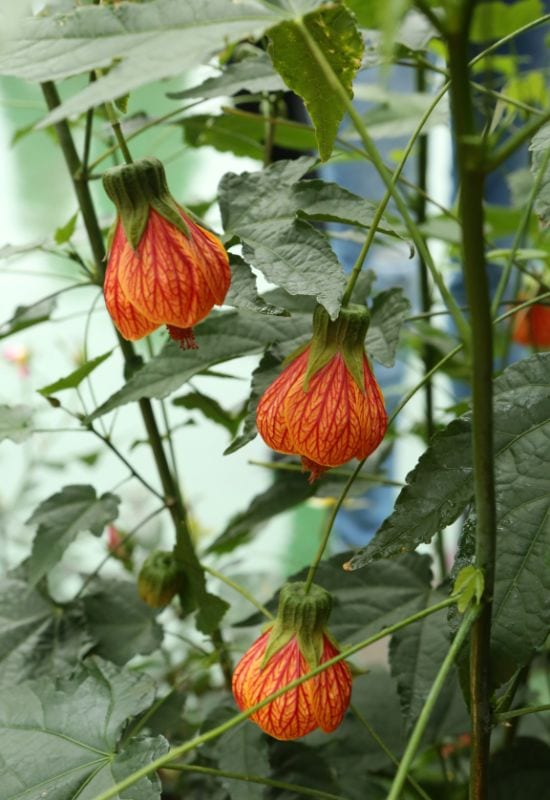
Here is the last orange beauty un our life and light injected journey, and this shrub too will blossom for months on end: ‘Victor Reiter’ flowering maple. In fact, you will see its bell shaped nodding blossoms come all through the season, from early spring to late fall!
Very attractive and waxy, glossy, with clear veins, they will display different tonalities of our color, from fire to tangerine, and the very center is actually golden, perfect to draw your eye in.
The staminal column with bright anthers completes the decorative effect of the blooms, which are about 3 inches across (7.5 cm) and very showy indeed! Hummingbirds and butterflies love them, and they too will brighten up your garden with a spark of life.
The maple like leaves are smooth and deep green, and they will stay on this bush all through the winter months, being evergreen.
Grow ‘Victor Reiter’ as a specimen plant, especially if you want to train it into a small tree, or in hedges, by your wall side… It will always attract lots of attention with its beautiful orange flowers, and it is quite suitable to oriental and tropical garden styles as well!
Bright Orange Blooms on Shrubs in Spring, Summer, Fall and Even Winter!
There is no season without orange blossoms if you need a shrub with flowers of this energetic but also very symbolic color. True, it is easier to have blooms of tangerine or apricot shades if you live in a warm region.
But there are also long blooming varieties for temperate areas, and there are so many different flower shapes, bush personalities and foliage texture that the choice can be – sometimes – really hard to make!

Written By
Amber Noyes
Amber Noyes was born and raised in a suburban California town, San Mateo. She holds a master’s degree in horticulture from the University of California as well as a BS in Biology from the University of San Francisco. With experience working on an organic farm, water conservation research, farmers’ markets, and plant nursery, she understands what makes plants thrive and how we can better understand the connection between microclimate and plant health. When she’s not on the land, Amber loves informing people of new ideas/things related to gardening, especially organic gardening, houseplants, and growing plants in a small space.

